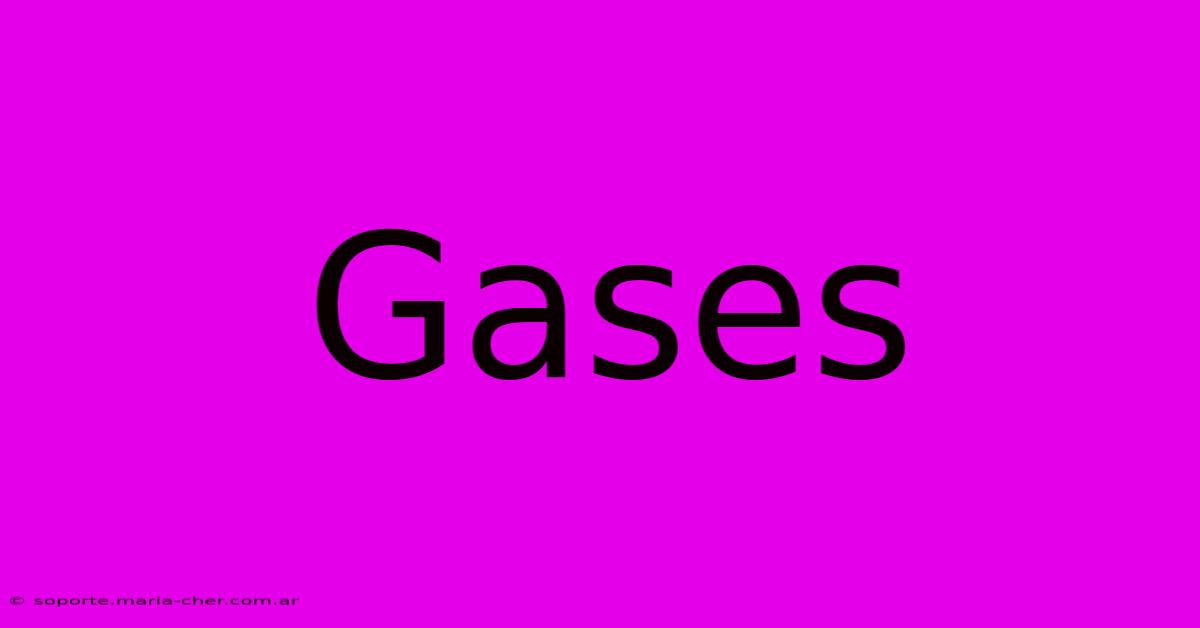Gases

Table of Contents
Understanding Gases: Properties, Behavior, and Applications
Gases are one of the four fundamental states of matter, characterized by their lack of definite shape or volume. They readily expand to fill any container they occupy, making them fascinating and crucial components of our world. This comprehensive guide delves into the properties, behavior, and diverse applications of gases.
Properties of Gases
Several key properties define and distinguish gases:
-
No fixed shape or volume: Gases assume the shape and volume of their container. This is because the particles in a gas are far apart and move randomly.
-
Compressibility: Gases can be easily compressed, reducing their volume significantly. This is due to the large spaces between gas particles.
-
Expansibility: Gases readily expand to fill the available space. This is a direct result of the constant, random motion of gas particles.
-
Low density: Gases have much lower densities than solids or liquids, as their particles are widely dispersed.
-
Diffusion and effusion: Gases readily mix with each other (diffusion) and pass through small openings (effusion), a consequence of their particle motion.
The Kinetic Molecular Theory of Gases
The behavior of gases is best explained by the kinetic molecular theory (KMT). This theory postulates that:
- Gases consist of tiny particles (atoms or molecules) that are in constant, random motion.
- These particles are far apart compared to their size.
- The forces of attraction between gas particles are negligible.
- Collisions between gas particles and container walls are perfectly elastic (no energy loss).
- The average kinetic energy of gas particles is directly proportional to the absolute temperature.
Gas Laws
Several gas laws describe the relationship between pressure (P), volume (V), temperature (T), and the amount of gas (n, usually measured in moles):
- Boyle's Law: At constant temperature, the volume of a gas is inversely proportional to its pressure (P₁V₁ = P₂V₂).
- Charles's Law: At constant pressure, the volume of a gas is directly proportional to its absolute temperature (V₁/T₁ = V₂/T₂).
- Gay-Lussac's Law: At constant volume, the pressure of a gas is directly proportional to its absolute temperature (P₁/T₁ = P₂/T₂).
- Avogadro's Law: Equal volumes of gases at the same temperature and pressure contain equal numbers of molecules.
- Ideal Gas Law: Combines the above laws into a single equation: PV = nRT, where R is the ideal gas constant.
Deviations from Ideal Gas Behavior
The ideal gas law provides a good approximation for many gases under normal conditions. However, at high pressures or low temperatures, real gases deviate from ideal behavior. This is because the assumptions of negligible intermolecular forces and negligible particle volume are no longer valid.
Applications of Gases
Gases play vital roles in numerous areas:
-
Atmospheric gases: The Earth's atmosphere, composed primarily of nitrogen and oxygen, is crucial for life. Other gases like carbon dioxide and ozone play important roles in climate regulation and protection from harmful radiation.
-
Industrial processes: Gases are widely used in various industrial applications, including chemical synthesis, manufacturing, and energy production. Examples include the use of oxygen in steelmaking and nitrogen in food preservation.
-
Medical applications: Gases such as oxygen are essential in medical treatments, while other gases are used in anesthesia and medical imaging.
-
Transportation: Gases like natural gas are used as fuels, and compressed air is vital for powering pneumatic systems in vehicles.
-
Refrigeration and air conditioning: Certain gases, known as refrigerants, are crucial for cooling systems.
Conclusion
Gases, while often invisible, are fundamental to our understanding of the world and essential to countless applications. By understanding their properties, behavior, and the laws that govern them, we can better harness their power for various purposes. Further research into gas behavior, particularly concerning real gases and their impact on the environment, remains vital for future advancements in science and technology.

Thank you for visiting our website wich cover about Gases. We hope the information provided has been useful to you. Feel free to contact us if you have any questions or need further assistance. See you next time and dont miss to bookmark.
Featured Posts
-
Perry Homes Corporate Headquarters A Masterpiece Of Texan Grandeur
Feb 05, 2025
-
Plan Trump Israel Accueilli Favorablement
Feb 05, 2025
-
2025 Lakers Clippers Odds And Prediction
Feb 05, 2025
-
Ismaelisme Comprendre Apres La Mort De L Aga Khan
Feb 05, 2025
-
2025 Lakers Clippers Nba Livestream
Feb 05, 2025
